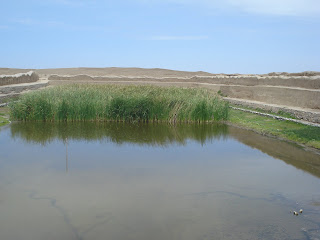On the day after we arrived in Trujillo/Huanchaco, we decided to go to Chan Chan (more ruins! and one of our main reasons for stopping in that area). It is (or was?) the largest adobe city in the world, built by the Chimu culture. You can see how expansive just the ruins that are left are from driving by on the road. Only a very small part of it has been restored, and, according to all of the tour books it's not a good idea to go wandering around the other parts of the site because there have been reports of "violent attacks on tourists." So, Maya and I decided to stay in just the part that was restored and had security guards. When we first arrived in the morning, the site was still closed because it had rained the night before (this causes the walls to essentially melt sine they are made of dirt). They told us, however, that it would open in up in about hour. So, to kill time we went into Trujillo to get bus tickets for Guayaquil (which ended up being sold out the day we wanted to go with the company we wanted to go with, so we just got tickets with that company to Piura where the plan was to change buses for one up to Guayaquil). When we came back, the site was open (oh yes, we also had to take the $5 dollar taxi instead of the 50 cent bus because the tour books say not to walk along the road unless you are in a big group, because, again, there have been reports of attacks on tourists...get your stuff together Peru!!) Anyways, we decided our safety was worth the extra couple dollars. To get from the highway to the restored part of the ruins you drive through the rest of the city which as not been restored. It seems like there are adobe walls that go on FOREVER. And, considering the whole thing is made out of mud, it's quite impressive how much of it has stood the test of time and rain and everything else that has been thrown at it (it was constructed around 850 AD and was the largest pre-colombian city in South America). At it's high point, around 60,000 people lived in the city...that's a lot for a mud city!
Here's some picture's from the day:

The melting wall of the city after the rain :( You're not really allowed to touch everything for fear that it will crumble. I'm guessing children were discouraged from having waterfights back in the day...
Apparently every time it rains they just try and through tarps over the part of the city that has been restored. Then, when the rain passes, the walk around with a bag of dirt to restore the parts that have been ruined.
Apparently every time it rains they just try and through tarps over the part of the city that has been restored. Then, when the rain passes, the walk around with a bag of dirt to restore the parts that have been ruined.

Random lake in the middle of the city. Apparently after the city was abandoned, they used this area for leaving offerings for the gods. (I'm a little unclear about whether there was always a lake or not).

A room where they think that kept statues of their gods and also left them offerings.

The fish signs that guided us through our self guided tour of the city. follow the yellow fish-sign...

Maya and I are guessing that these were probably houses, although they didn't have a sign to clarify for us. There were a bunch of little square boxes that all looked the same. And, in the background, you can see the really tall wall that ran around the whole city.

I can't believe they made so much stuff out of mud! It's crazy. It also seems slightly impractical, although I guess since we're still looking at it 1200 years later, it wasn't such a bad idea after all. The whole city was like a labyrinth, because you couldn't see over any of the walls. I don't understand how people didn't get lost back in the day, they didn't have those nice little yellow fish signs to guide them through the city...
 Some really cool designs they carved into the wall. The fish are supposed to be in the shape of ocean waves. Their culture depended a lot on the ocean for nutrients, so they would make offerings and carve designs about it to bring them good luck and food.
Some really cool designs they carved into the wall. The fish are supposed to be in the shape of ocean waves. Their culture depended a lot on the ocean for nutrients, so they would make offerings and carve designs about it to bring them good luck and food. A guy wandering around dressed in "period" dress like the nobility. They would wear gold plated shirts, headresses, necklaces, nose pieces, earings...etc.
A guy wandering around dressed in "period" dress like the nobility. They would wear gold plated shirts, headresses, necklaces, nose pieces, earings...etc.

No comments:
Post a Comment